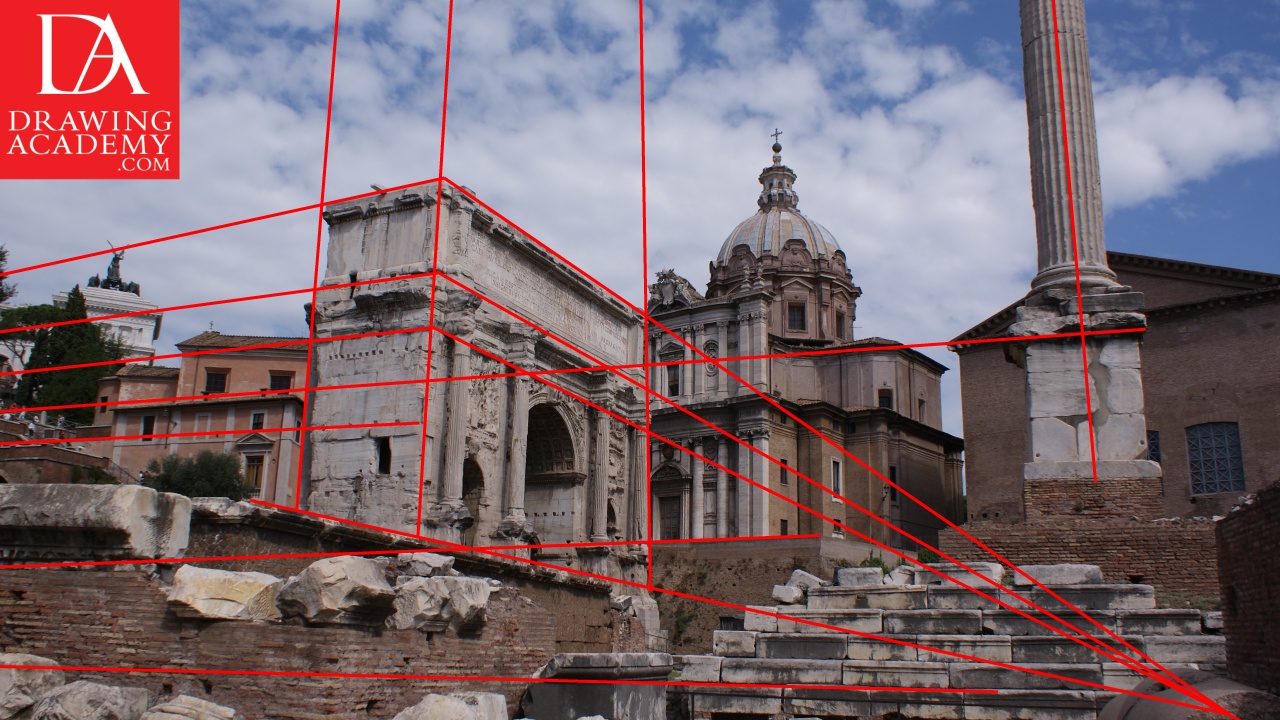Perspective in Drawing – Three-Point Perspective, Four-Point Perspective, Aerial Perspective
In this video part you will discover when and how to use perspective in drawing applying the three-point perspective, four-point perspective, and aerial perspective.
Enroll in the Drawing Academy Course
Pay once - Enjoy forever!
Only $297
Three-Point Perspective
There are cases of perspective in drawing, when an object is seen from far above or below. In such instances very likely three-point perspective will present the object in most believable aspect. This applies to cases when vertical lines of tall objects are seen not parallel to each other.
For example, a rectangular prism, which is seen from above, has lines of its side edges converging in two vanishing points on the horizon line. At the same time vertical lines of this prism are not parallel. As we are observing this object from far above, it appears that vertical edges are also pointing into the vanishing point that is located way below us. So, in this case we have a three-point perspective in drawing.

Three-point perspective in drawing is used when objects are far below or far above the viewer’s head. When we look on the objects from the above, we are likely to tilt the head downward, so the third vanishing point will be located way-below us.
Vice-versa, looking on objects high above, we turn heads up and the third vanishing point is located way above the viewer’s head.
In this video part you will see numerous examples of real life photos where three-point perspective in drawing is very apparent. I will give full explanation how three-point perspective in drawing rules work and when to use them.
Four-Point Perspective
Four-point perspective is more advanced that three-point perspective in drawing. It has the closest representation of objects seen in real life.
We see a three-dimensional world that cannot be interpreted without distortion on a two-dimensional surface of drawing. The four-point perspective in drawing is as close as we can get to imitate a 3D reality on a flat surface. We see the world around us both below and above our eye level.
Here is a shocking truth about drawing realistic objects on a flat surface in perspective. We see only two lines as absolutely straight strings. One is the horizon line that goes at the viewer’s eye level. Another is the vertical line that goes right in front of the viewer. All other lines must be seen bended at a different curvature despite being perfectly straight in reality. Human brain perceives those lines as straight when observing perspective in drawing.
To draw realistically looking objects, we have to approximate curved lines as straight and ignore slight tilts of vertical lines. We have to choose which perspective one- two- three- or four-point fits better for a drawing and give the least distortion.
Aerial Perspective
So far we only analyzed the linear perspective in drawing. It is time to talk about how atmosphere affects the look of objects we see around.
Aerial perspective in drawing changes the way objects look, depending on the distance from the viewer. Objects appear paler, lighter, less saturated in color, and have less contrast the further away they are. This is because of air has small drops of water which colors the sky in blue, Atmosphere is very transparent, but on big distances you can see how air affects the background color making it bluer. During sunset, the sun reflects from the air and faraway objects may become colored in orange and red.
Atmospheric perspective in drawing changes appearance of objects depending on the distance between an object and the viewer. The further the object is, the less saturated its colors become; the contrast is reduced and small details disappear altogether.
This video will present you good examples of aerial perspective in drawing and explain in details all you need to know about aerial perspective to draw realistically.
The linear and atmospheric perspective in drawing is something you cannot ignore in your drawings if you want to make realistic artworks.
Great art starts with a beautiful drawing and knowledge of perspective in drawing is the must have tool of every professional fine artist.





Comments are closed.